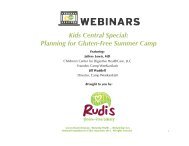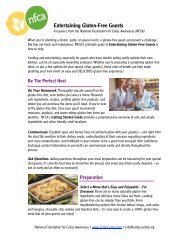504 Plan Roadmap - National Foundation for Celiac Awareness
504 Plan Roadmap - National Foundation for Celiac Awareness
504 Plan Roadmap - National Foundation for Celiac Awareness
You also want an ePaper? Increase the reach of your titles
YUMPU automatically turns print PDFs into web optimized ePapers that Google loves.
<strong>504</strong> <strong>Plan</strong> <strong>Roadmap</strong> <strong>for</strong> the Accommodation of a<br />
Student with <strong>Celiac</strong> Disease<br />
A resource created by the <strong>National</strong> <strong>Foundation</strong> <strong>for</strong> <strong>Celiac</strong> <strong>Awareness</strong> (NFCA)<br />
This roadmap is not meant to be legal advice nor definitive resource. Rather, it is insight<br />
into this process and should be adjusted <strong>for</strong> individual circumstances.<br />
Section <strong>504</strong> is part of the Rehabilitation Act of 1973, and applies to all institutions<br />
receiving federal financial assistance, such as public schools. Under this law, public<br />
schools must provide a free appropriate public education and not discriminate against<br />
disabled students.<br />
This law acknowledges that the disability may not require special education services but a<br />
plan is needed to ensure the student receives an appropriate education accommodating the<br />
disability within the classroom. This law must accommodate a special diet, including a<br />
gluten-free diet, the only known treatment <strong>for</strong> celiac disease.<br />
STUDENT INFORMATION<br />
• Name of the Student<br />
• Name of Student’s Parents<br />
• Date of Birth of the Student<br />
• Grade of the Student<br />
• School Child Attends<br />
• Name of the School District<br />
• Date of the Current <strong>504</strong> Meeting<br />
• Date of the Next <strong>504</strong> Meeting<br />
<strong>504</strong> TEAM INFORMATION<br />
• Child’s Parents and contact<br />
in<strong>for</strong>mation<br />
• Primary Classroom Teacher<br />
• School Nurse<br />
• <strong>504</strong> Coordinator<br />
• School Counselor or Psychologist<br />
• Director of Foodservices or<br />
Cafeteria<br />
BACKGROUND INFORMATION<br />
What is celiac disease<br />
<strong>Celiac</strong> disease is a hereditary autoimmune disease that damages the villi of the small intestine<br />
and interferes with absorption of nutrients from food. What does this mean Put simply, the<br />
body is attacking itself! <strong>Celiac</strong> disease is triggered by consumption of the protein called gluten,<br />
which is found in wheat, barley and rye. When people with celiac disease eat foods containing<br />
gluten, their immune system responds by damaging the fingerlike villi of the small intestine.<br />
When the villi become damaged, the body is unable to absorb nutrients into the bloodstream.<br />
<strong>National</strong> <strong>Foundation</strong> <strong>for</strong> <strong>Celiac</strong> <strong>Awareness</strong> ⎢P.O. Box 544, Ambler, PA 19002<br />
215‐325‐1306 ⎢ www.<strong>Celiac</strong>Central.org ⎢ info@celiaccentral.org
What is the treatment<br />
The only treatment <strong>for</strong> celiac disease is a 100%, life-long gluten-free diet, which means<br />
avoiding all <strong>for</strong>ms of wheat, barley and rye. A special caution must be given to oats, which in<br />
their natural <strong>for</strong>m do not contain the gluten protein. However, most fields where oats are grown<br />
and mills that produce and store oats also manufacture wheat, barley or rye, resulting in crosscontamination.<br />
Current research shows that the majority of patients with celiac disease can<br />
tolerate oats in their pure, uncontaminated <strong>for</strong>m. It is important that oat consumption be<br />
limited to oats with one of the following labels: “pure, uncontaminated oats, ” “gluten-free, ” or<br />
“certified gluten-free oats.” It is recommended that oats be introduced under medical<br />
supervision and slowly.<br />
Despite these restrictions, people with celiac disease can eat a well-balanced diet that consists<br />
of healthy and delicious foods. Even though it may seem impossible to maintain the diet at<br />
school, these simple guidelines will ensure that your child has the best possible experience<br />
throughout their school years.<br />
OVERVIEW OF THE CHILD’S CONDITION<br />
• History of celiac disease of child:<br />
o Year of diagnosis<br />
o Amount of time on a gluten-free diet<br />
• Basis <strong>for</strong> the determination of the disability:<br />
o Refer to letter from doctor/physician initiating <strong>504</strong> plan<br />
• Disability that affects a major life activity:<br />
o Restricted diet, gluten-free<br />
• Child’s developmental level and needs:<br />
o Self-reliance <strong>for</strong> the student in managing their diet and disease. This fluctuates<br />
individually and developmentally. Some indicators of a child’s readiness: The<br />
student is always able to visually recognize the allergen in all its hidden <strong>for</strong>ms or<br />
part of another food (starch, malt, play dough, etc.).<br />
__________Yes _____________No<br />
o The student is always able to read labels <strong>for</strong> gluten.<br />
__________Yes _____________No<br />
o The student is always able to verbally communicate body discom<strong>for</strong>t associated<br />
with a reaction. __________Yes _____________No<br />
o The student always knows to wash his/her hands well with an approved soap and<br />
warm water be<strong>for</strong>e eating. __________Yes _____________No<br />
o The student always knows to eat only food brought from home. (If arranged)<br />
__________Yes _____________No<br />
<strong>National</strong> <strong>Foundation</strong> <strong>for</strong> <strong>Celiac</strong> <strong>Awareness</strong> ⎢P.O. Box 544, Ambler, PA 19002<br />
215‐325‐1306 ⎢ www.<strong>Celiac</strong>Central.org ⎢ info@celiaccentral.org
o The student always knows not to trade food with classmates and adults.<br />
__________Yes _____________No<br />
o The student always understands how a safe food may become cross-contaminated<br />
with gluten. __________Yes _____________No<br />
GOALS OF THE <strong>504</strong> PLAN - examples<br />
1. Adhering to all aspects of the <strong>504</strong> <strong>Plan</strong> to avoid gluten.<br />
2. Assisting the child to maintain a stable physiological state void of gluten reactions through<br />
preventative measures.<br />
3. Recognizing the signs of a reaction and treating it promptly in all school contexts.<br />
4. Striking a balance between safety and social normalcy, providing the same opportunities and<br />
conditions as the child’s peers, and offering encouragement to the child.<br />
5. Encouraging open and on-going communication among adults about food intolerance issues<br />
and doing so discretely and in the appropriate <strong>for</strong>um.<br />
PART F: FOOD ALLERGY EDUCATION, AWARENESS & REACTION PREVENTION<br />
The basic question to be answered and discussed in this section: What kind of training needs to<br />
take place to promote education, awareness and reaction prevention in the school context<br />
Types of Education, <strong>Awareness</strong> and Reaction Prevention:<br />
• Label reading.<br />
• Proper hand washing.<br />
• What is cross contamination and how can it be avoided<br />
• Effective table and desk washing with appropriate chemicals and materials<br />
• Positive role modeling (Example: A positive role model would not make statements to<br />
parents and students such as, “We cannot have a holiday party because of “Suzy”<br />
<strong>Celiac</strong> and her food allergies.” A positive role model would say, “We are going to have<br />
a holiday party and we will make it fun and safe <strong>for</strong> everyone.”)<br />
• Promotion of positive self-esteem <strong>for</strong> child with celiac disease .<br />
• Promotion of peer support <strong>for</strong> child with celiac disease.<br />
COMMUNICATION MANAGEMENT<br />
A plan should be made <strong>for</strong> communication amongst those on the team and possibly include a<br />
provision <strong>for</strong> parents to be included in all communication about this subject. The most<br />
important conduits in the communication management plan will between the parents and the<br />
school cafeteria or food provider and the parents and the homeroom or primary teacher. A<br />
communication plan should be available in the event a substitute is covering a class.<br />
CLASSROOM MANAGEMENT<br />
• Parent and teacher will work together to monitor classroom events that may include the<br />
use of food.<br />
• An alternative to using food treats <strong>for</strong> students’ birthdays can be selected.<br />
• Class activities using envelopes will be minimized and child reminded not to lick any<br />
envelope/stickers in class.<br />
<strong>National</strong> <strong>Foundation</strong> <strong>for</strong> <strong>Celiac</strong> <strong>Awareness</strong> ⎢P.O. Box 544, Ambler, PA 19002<br />
215‐325‐1306 ⎢ www.<strong>Celiac</strong>Central.org ⎢ info@celiaccentral.org
• Student should be allowed bathroom privileges when necessary.<br />
• Student must be careful with use of the following materials <strong>for</strong> classroom projects or<br />
completely avoid their use: play dough, paper mache, fruit loops and cheerios and<br />
other gluten containing food, pasta, flour, paste, envelope and stamp adhesives. Hands<br />
and surfaces must be completely washed after the use of these materials. Parents will<br />
provide a list of alternative materials if the class plans to use any of these materials.<br />
• The teacher will communicate with parents about upcoming projects that may require<br />
alternative foods or materials.<br />
Nurse or Medical Department<br />
• Faculty and staff training regarding the plan.<br />
• Provide presentation and or in<strong>for</strong>mation to staff and class on celiac disease and the<br />
gluten-free diet.<br />
Art Room<br />
• Food will not be distributed in the art classroom.<br />
• Products commonly used in the art room will be reviewed to determine that they are<br />
gluten-free. Any changes in art products will be communicated prior to instituting the<br />
change. (e.g. paper mache and play dough)<br />
• Student must be careful with use of the following materials <strong>for</strong> classroom projects or<br />
completely avoid their use: play dough, paper mache, fruit loops and cheerios and<br />
other gluten containing food, pasta, flour, paste, envelope and stamp adhesives. Hands<br />
and surfaces must be completely washed after the use of these materials. Parents will<br />
provide a list of alternative materials if the class plans to use any of these materials.<br />
Food Services<br />
• Food handling procedures that introduce gluten-free foods and prevent cross<br />
contamination are essential. The <strong>National</strong> <strong>Foundation</strong> <strong>for</strong> <strong>Celiac</strong> <strong>Awareness</strong> has a<br />
training program in place <strong>for</strong> schools called GREAT Schools. More in<strong>for</strong>mation can be<br />
found by visiting: www.<strong>Celiac</strong>Learning.com.<br />
• Assimilation: A goal of this is to assimilate the child into the regular structures of the<br />
school.<br />
• Separate is often unequal and kitchens are encouraged to have students on a gluten-free<br />
diet have the same choices as other students, just gluten-free<br />
• It is the parent’s responsibility to review food and approve items<br />
• The kitchen then is responsible to appraise parent of changes<br />
• Some options tried by other schools:<br />
o All side items are gluten-free<br />
o One day a week one entrée is gluten-free but available <strong>for</strong> everyone.<br />
o Bring in quick items to substitute: hamburger buns or pizza crust.<br />
• Parent and Food Services will work together to arrange procedures when student is<br />
ordering school lunch or bringing food from home that will require heating in the<br />
cafeteria. (e.g. warming in the oven on a separate foiled cookie sheet).<br />
<strong>National</strong> <strong>Foundation</strong> <strong>for</strong> <strong>Celiac</strong> <strong>Awareness</strong> ⎢P.O. Box 544, Ambler, PA 19002<br />
215‐325‐1306 ⎢ www.<strong>Celiac</strong>Central.org ⎢ info@celiaccentral.org
Field Trips<br />
• Teachers will communicate to parent if food will be provided as part of field trip. Parent<br />
will determine whether food is gluten-free and/or provide student with a safe<br />
alternative. Parents will have the option of keeping a child home if no provisions can<br />
be made without penalty to the student.<br />
Some other topics to be considered in this section:<br />
• Safety snack box provided by the family to be kept in classroom<br />
• Birthdays<br />
• After school events such as pizza night consider utilizing one of the many companies<br />
now providing gluten-free options: Zpizza, Godfather’s Pizza, Garlic Jims.<br />
• Holiday parties<br />
• In case of reaction: access to bathroom.<br />
• Emergency kits: If your school has kits <strong>for</strong> emergencies or evacuation, then what supplies<br />
will be provided <strong>for</strong> those on a gluten-free diet and by whom<br />
<strong>National</strong> <strong>Foundation</strong> <strong>for</strong> <strong>Celiac</strong> <strong>Awareness</strong> ⎢P.O. Box 544, Ambler, PA 19002<br />
215‐325‐1306 ⎢ www.<strong>Celiac</strong>Central.org ⎢ info@celiaccentral.org






